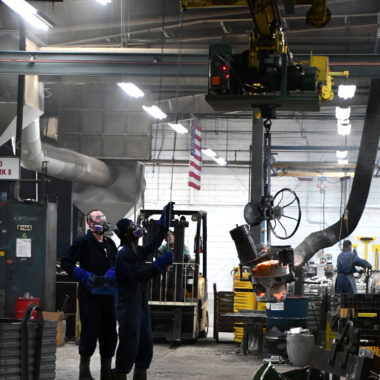Dive Into the World of Light Weight Aluminum Casting: Understanding the Various Approaches
Aluminum spreading is a basic procedure in the manufacturing market, with numerous approaches used to create exact and detailed components. Understanding the different strategies used in light weight aluminum spreading can give useful understandings into the capabilities and limitations of each technique. From the standard sand spreading technique to the sophisticated die spreading procedure, each technique supplies special benefits relying on the demands of the job. Discovering these varied techniques can supply a comprehensive sight of the opportunities within the globe of light weight aluminum spreading and just how each method adds to shaping the contemporary manufacturing landscape.
Sand Casting Technique
Sand casting, a widely-used method in aluminum casting processes, involves producing molds made of compacted sand for pouring liquified steel. Once the mold and mildew is all set, it is firmly put in a flask and molten aluminum is put right into the dental caries.
After the metal has cooled and strengthened, the sand mold and mildew is damaged away to expose the aluminum spreading. Sand spreading allows for the production of complicated forms and big components that might be hard or costly to produce making use of various other techniques. It is also a lasting strategy as the sand can be reused and utilized multiple times, reducing waste in the spreading process.
Permanent Mold Strategy

One significant benefit of the Irreversible Mold And Mildew Strategy is the boosted dimensional accuracy it offers. The steel mold and mildew permits for tighter resistances and better information in the last light weight aluminum castings compared to sand spreading methods. This accuracy makes it a favored option for applications where tight dimensional control is important, such as in the automobile and aerospace markets.

Die Casting Process

Financial Investment Casting Strategy
Making use of a precision casting approach, Investment Casting Approach involves developing detailed aluminum parts by putting molten steel into a ceramic mold and mildew. This process, also recognized as lost-wax casting, starts with the creation of a wax pattern of the wanted part (aluminum casting).
Investment spreading is typically used for manufacturing components in markets where intricate styles and limited resistances are required, such as aerospace, vehicle, and clinical tools. The flexibility and precision of the Investment Casting Technique make it a beneficial technique in the world of aluminum casting.
Lost Foam Casting Approach
Having actually discovered the intricate precision of Investment Casting Technique, the focus now moves to the ingenious approach of Lost Foam Spreading in light weight aluminum part manufacturing. Lost Foam Spreading, additionally called evaporative pattern spreading, is a modern-day strategy where a foam pattern of the preferred component is developed and after that covered with a refractory product. The layered foam pattern is after that buried in sand, and molten aluminum is poured right into the mold and mildew. As the steel loads the mold and mildew, the click resources foam evaporates because of the warm, leaving a clean tooth cavity in the shape of the desired part.
Among the main benefits of Lost Foam Casting is its capacity to create complex forms with complex details, typically in a single item without the need for additional machining. This approach is additionally understood for its high dimensional accuracy and smooth surface area finish. Furthermore, Lost Foam Spreading is a cost-efficient process as it reduces the demand for cores and enables for the production of lightweight components. Regardless of its benefits, Lost Foam Casting needs careful control of read this the spreading procedure to guarantee and protect against flaws high quality components.
Conclusion
To conclude, aluminum casting uses a variety of approaches such as sand spreading, permanent mold and mildew strategy, die casting, financial investment casting, and lost foam spreading. Each approach has its very own advantages and applications, making aluminum casting a functional and widely utilized procedure in numerous sectors. Understanding the differences in between these approaches is essential in choosing one of the most ideal spreading strategy for specific production requirements.
Sand casting, a visit this page widely-used technique in light weight aluminum spreading processes, involves creating molds made of compacted sand for pouring molten steel. aluminum casting.The Permanent Mold Technique, like sand casting, is an additional prevalent technique employed in aluminum spreading procedures, using unique benefits in terms of mold and mildew reusability and dimensional accuracy. The metal mold permits for tighter tolerances and finer information in the last light weight aluminum spreadings contrasted to sand spreading approaches. The 2 major kinds of die casting are cold chamber die casting and hot chamber die spreading, each appropriate for various types of light weight aluminum alloys.In final thought, light weight aluminum casting provides a selection of approaches such as sand spreading, irreversible mold and mildew method, pass away casting, investment casting, and lost foam spreading